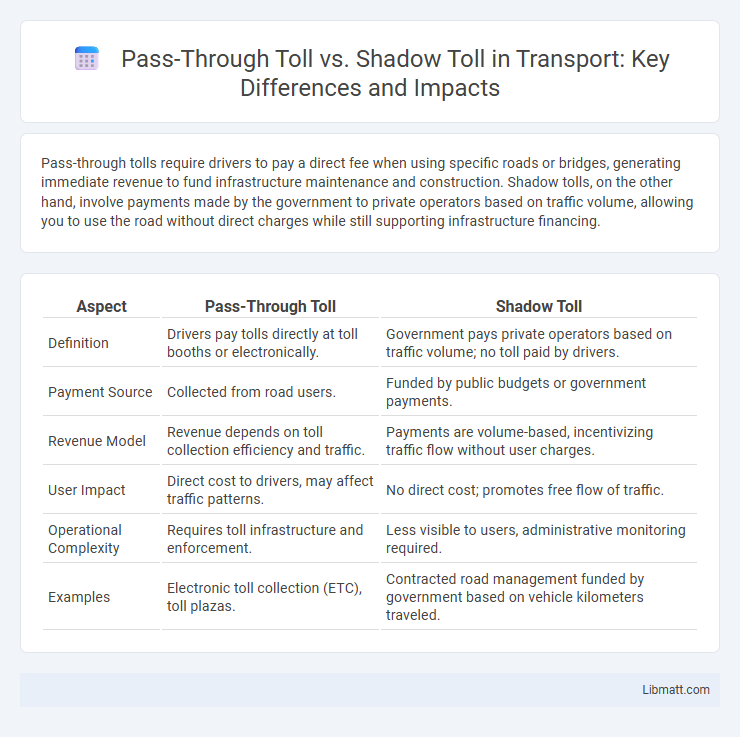Pass-through tolls require drivers to pay a direct fee when using specific roads or bridges, generating immediate revenue to fund infrastructure maintenance and construction. Shadow tolls, on the other hand, involve payments made by the government to private operators based on traffic volume, allowing you to use the road without direct charges while still supporting infrastructure financing.
Table of Comparison
| Aspect | Pass-Through Toll | Shadow Toll |
|---|---|---|
| Definition | Drivers pay tolls directly at toll booths or electronically. | Government pays private operators based on traffic volume; no toll paid by drivers. |
| Payment Source | Collected from road users. | Funded by public budgets or government payments. |
| Revenue Model | Revenue depends on toll collection efficiency and traffic. | Payments are volume-based, incentivizing traffic flow without user charges. |
| User Impact | Direct cost to drivers, may affect traffic patterns. | No direct cost; promotes free flow of traffic. |
| Operational Complexity | Requires toll infrastructure and enforcement. | Less visible to users, administrative monitoring required. |
| Examples | Electronic toll collection (ETC), toll plazas. | Contracted road management funded by government based on vehicle kilometers traveled. |
Introduction to Pass-Through Tolls and Shadow Tolls
Pass-through tolls require drivers to pay fees directly at toll plazas or via electronic toll collection systems, allowing immediate cost recovery for infrastructure projects. Shadow tolls, in contrast, involve payments made by government agencies to private road operators based on traffic volumes, meaning drivers do not pay tolls directly. Your understanding of these models impacts decisions on financing and managing transportation infrastructure efficiently.
Definition and Mechanism of Pass-Through Tolls
Pass-through tolls are a financing mechanism where toll revenues collected from road users are transferred to fund the operation and maintenance of the infrastructure, typically involving private sector participation. This system allows the government to recover project costs based on actual traffic volumes, reducing financial risk by adjusting payments relative to toll income. You benefit from a transparent structure where toll charges directly support road services, ensuring efficient allocation of funds and sustainable infrastructure management.
Understanding Shadow Tolls: How They Work
Shadow tolls are payments made by the government to private road operators based on traffic volume rather than direct user fees, contrasting with pass-through tolls where drivers pay at toll booths. These hidden tolls incentivize private companies to maintain and improve infrastructure without charging drivers directly, affecting traffic flow and public spending. Your understanding of shadow tolls highlights their role in public-private partnerships and infrastructure financing models.
Key Differences Between Pass-Through and Shadow Tolls
Pass-through tolls require drivers to pay directly at toll booths or via electronic toll collection systems, generating immediate revenue linked to actual road usage. Shadow tolls, by contrast, involve payments made by government authorities to private operators based on vehicle traffic counts without charging drivers directly, shifting financial risk away from users. Your choice between these tolling methods depends on factors like user cost visibility, revenue risk management, and funding model preferences.
Financial Implications for Governments
Pass-through tolls require governments to directly collect fees from road users, generating immediate revenue but often involving higher administrative costs and maintenance liabilities. Shadow tolls shift financial responsibility to the government, which pays private operators based on traffic volumes, reducing upfront costs but creating long-term fiscal commitments contingent on road usage. Your choice between these models affects budget predictability and impacts how public funds are allocated for infrastructure development and maintenance.
Impact on Drivers and Road Users
Pass-through tolls require direct payment from drivers when using specific roadways, impacting your travel budget and potentially influencing route choices due to visible costs. Shadow tolls, however, impose no immediate payment on road users, as government agencies compensate private operators based on traffic volumes, allowing for uninterrupted toll-free travel experiences. This model minimizes driver inconvenience but may affect public funds, indirectly influencing overall road maintenance and service quality.
Pros and Cons of Pass-Through Toll Systems
Pass-through toll systems allow governments to leverage private investment for infrastructure projects, reducing immediate public expenditure while ensuring project delivery. They provide clear revenue streams tied directly to user fees, promoting efficient road usage and maintenance but may lead to higher costs for drivers due to direct toll collection. However, pass-through tolls can face public resistance and require robust regulatory frameworks to balance private profits with fair pricing and accessibility.
Advantages and Disadvantages of Shadow Toll Systems
Shadow toll systems offer the advantage of reducing direct financial burden on drivers, as payments are made by governments to private operators based on traffic volume rather than toll collection at the point of use. This arrangement can encourage better road maintenance and operational efficiency since payments are linked to performance metrics. However, shadow tolls may lead to higher public expenditure over time, potential underreporting of traffic data, and reduced transparency compared to pass-through toll systems where users directly pay for road usage.
Global Case Studies and Real-World Applications
Pass-through toll schemes have been effectively implemented in the United States, notably for infrastructure projects where users directly pay toll fees, such as the Illinois Tollway system, promoting transparency and operational cost recovery. Shadow toll models are prevalent in the United Kingdom and parts of Europe, where governments compensate private operators based on vehicle usage without direct driver charges, exemplified by the M6 Toll road in England, optimizing public-private partnerships and reducing initial user burden. These global case studies highlight contrasting financial structures and risk allocations, influencing project scalability, user acceptance, and long-term maintenance efficiency.
Which Toll Model Best Supports Infrastructure Development?
Pass-through tolls directly charge drivers based on actual road usage, generating immediate revenue that supports timely infrastructure development and maintenance. Shadow tolls rely on government payments to private operators based on traffic volumes, enabling infrastructure expansion without upfront costs but potentially delaying funding flows. Your choice depends on whether immediate funding or long-term budget management better aligns with your infrastructure goals.
pass-through toll vs shadow toll Infographic

 libmatt.com
libmatt.com